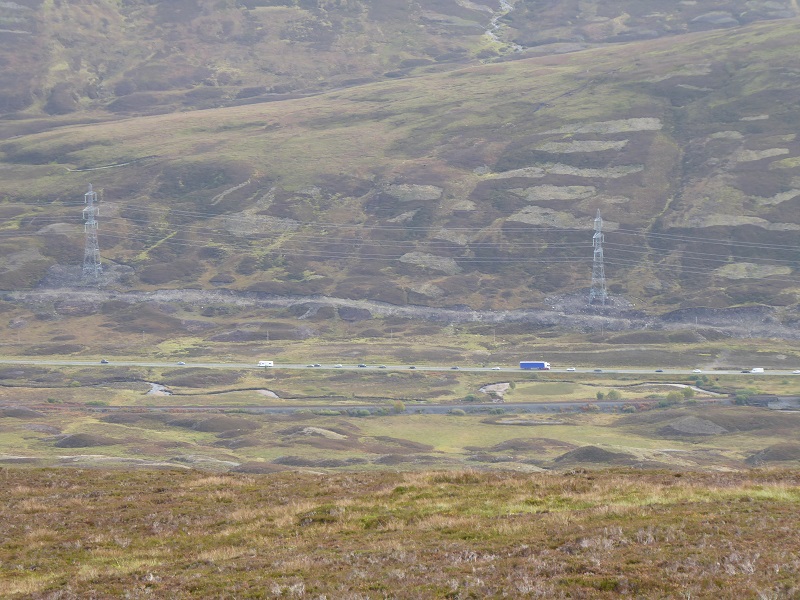
This post will consider the failure of Scottish and Southern Electric to date to restore the landscape caused by the Beauly Denny construction works in the northern section of the Drumochter.
A central planning assumption behind the Beauly Denny was that once the construction phase was complete the land would be restored to it original condition. Initially the main exception to this was the agreement by the Scottish Government that some existing tracks which were “upgraded” for construction purposes would be allowed to remain, including approx 7km in the Cairngorms National Park. Such tracks were described as “permanent” access tracks. (This, I have learned from helpful communications with SSE, includes the section of track on the Dalnacardoch Estate between Dalnaspidal and Drumochter (see here)). Subsequently, the Scottish Government decided that landowners could also apply to local planning authorities to retain “temporary” construction access tracks but these would require full planning permission. All other tracks, compounds and construction areas around the transmission towers were supposed to be restored to their original condition.
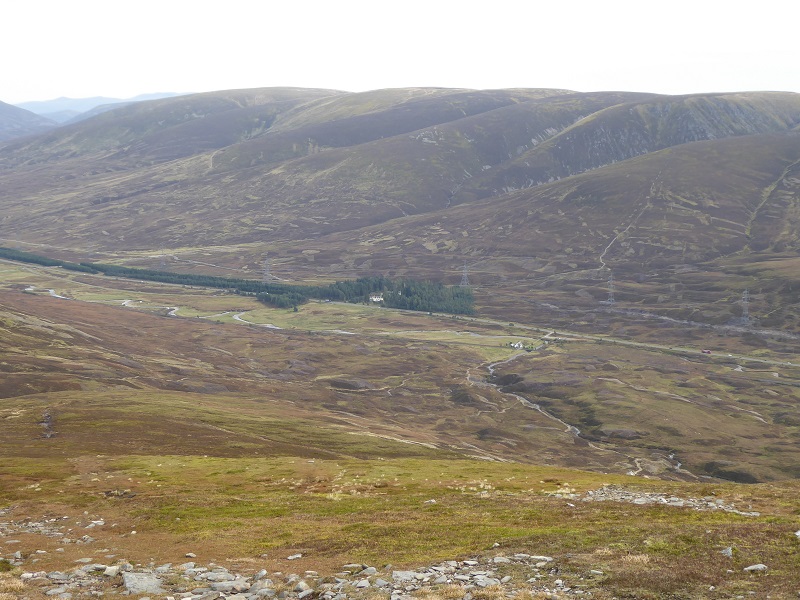
The Cairngorms National Park Authority has granted planning permission to the North Drumochter Estate to retain the section of track from North Drumochter Lodge to near Dalwhinnie (section of track to left of lodge behind shelter belt) on condition it is narrowed and the landscape impact reduced (see here). The northern part of this track (outside frame of photo) was restored in the summer but the North Drumochter Estate has subsequently applied to remove the requirement for native woodland planting around it – this will be considered in future post. The section considered in this post, where full restoration is required, lies between the south (right) of the north Drumochter Lodge policy woodlands to Drumochter summit. The line of the former construction track is still clearly visible in the photo above from a distance.
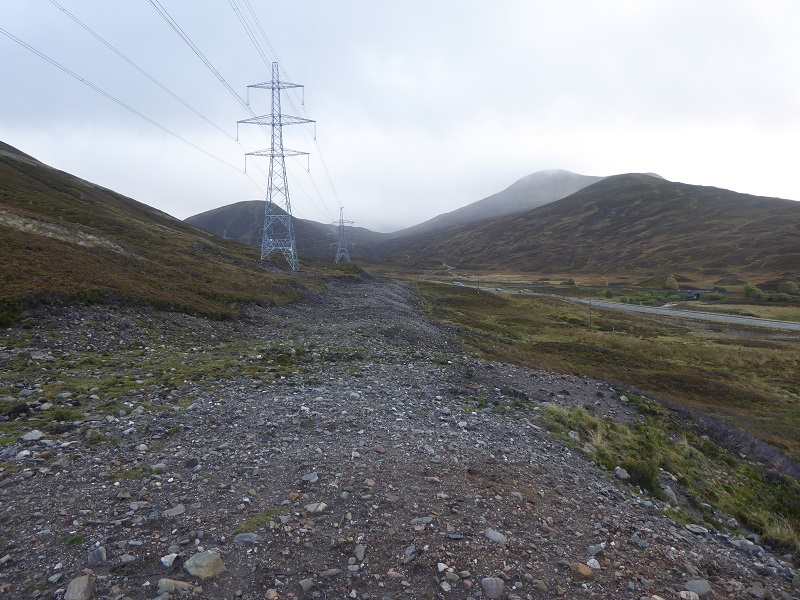
In my view the main reason for this is that the attempt to restore the former access track along this section has been risible. The photo above shows the bench that was cut across the hillside through cut and fill (the upper slope was cut and the lower filled in with the material excavated) remains. In effect the only restoration that has been carried out has been to break up the former track surface. The material which forms the line of the track should have been moulded back to match the contours of the hillside, with the “fill” material shifted uphill to cover the “cut” ground and banks on the upside of the track.
The consequence of leaving the track foundations in place is not only that a permanent line has been left across the hillside but as should have been quite predictable, the North Drumochter Estate has continued to use the line as a track. This will prevent full vegetation recovery even if the current plan, which is to leave restoration up to natural regeneration works.

The photos shows vehicles are still being driven from the section of track granted planning permission by the CNPA (which still requires to be narrowed) onto the section “restored” by SSE’s contractors creating a churned up motorway. This “restored” section is in the Drumochter Hills Site of Special Scientific Interest and off-track use of vehicles here needs consent by SNH. (I will ask if it has been granted). Unless the CNPA, SNH and SSE work together to stop vehicles being driven here the vegetation will never recover.
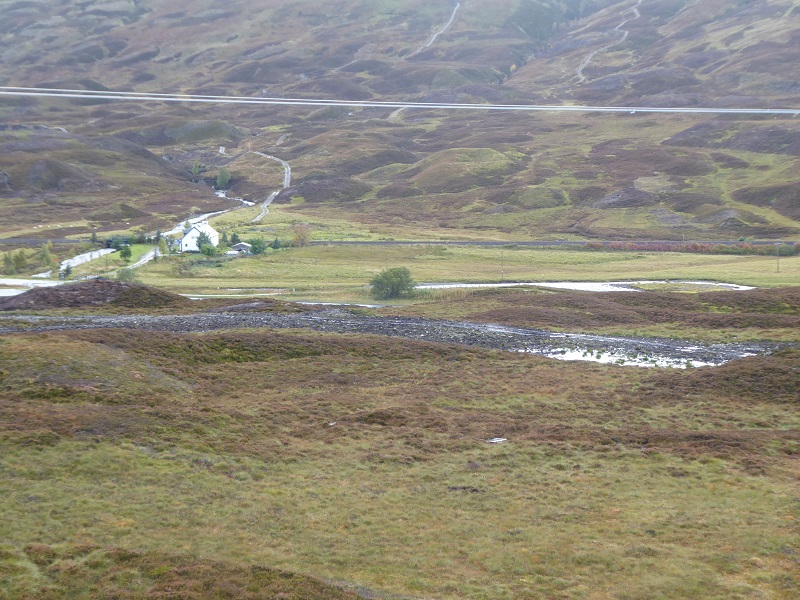

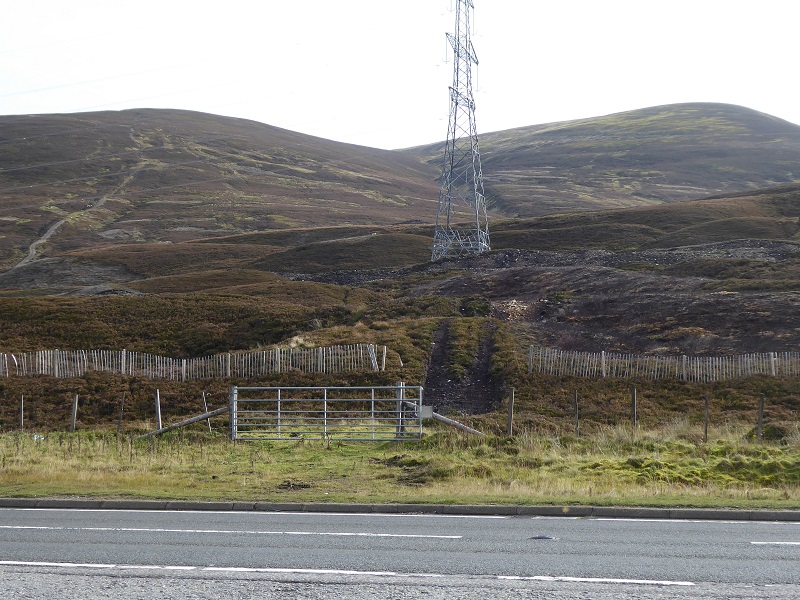
The use of vehicles has been facilitated by the creation of access gates from the A9 enabling vehicles to be driven up onto the line of the Beauly Denny construction track, creating more erosion and preventing vegetation recovery.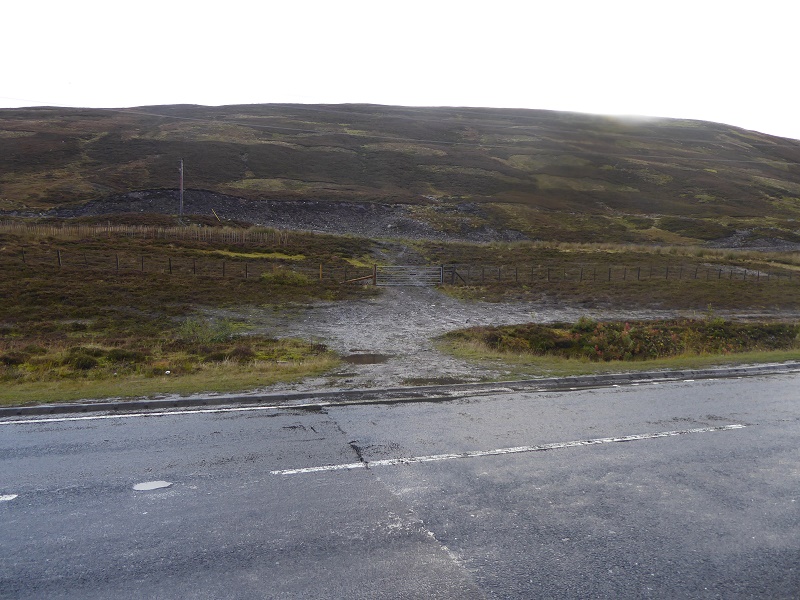
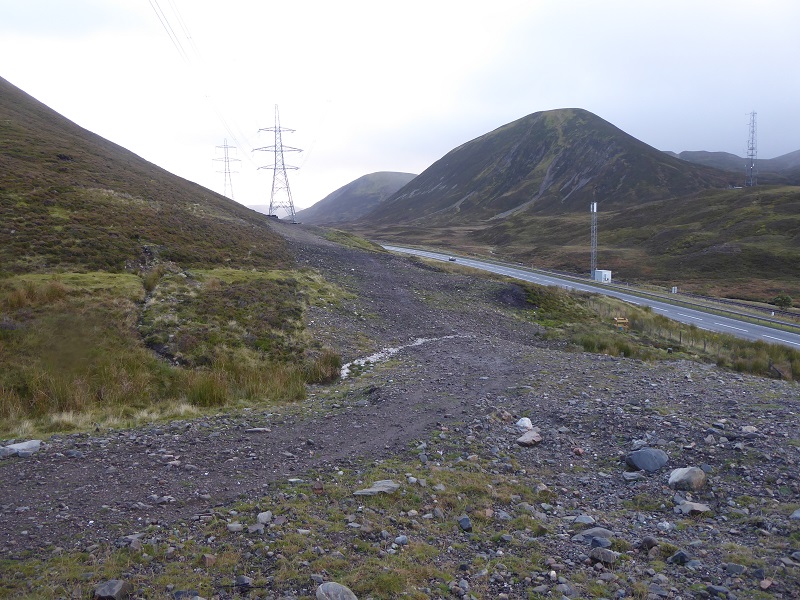
While the CNPA, to its credit has been very concerned about the poor restoration of this section of the Beauly Denny and the landscape scar which can be seen from the A9, so far its focus has been on the quality of the vegetation reinstatement.
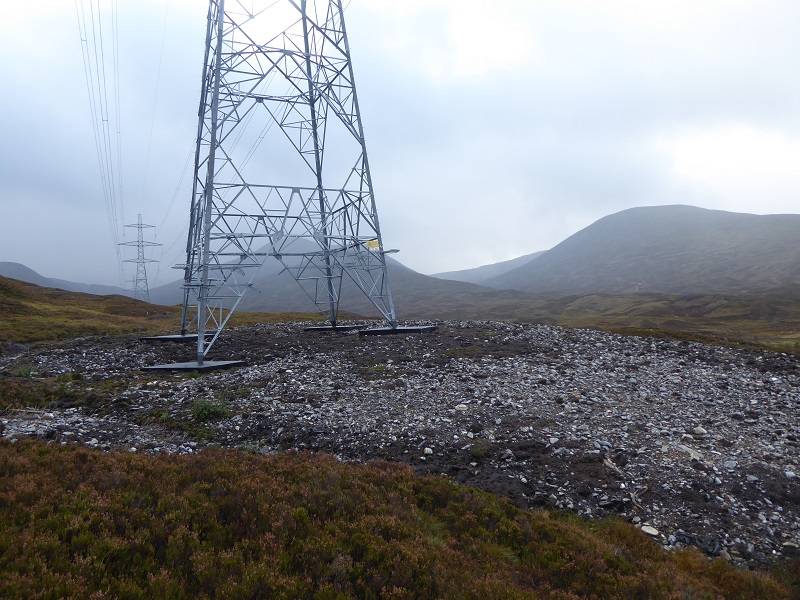
Some of the poor restoration around the tower bases has been explained by CNPA staff as being a consequence of a failure to store vegetation properly during the construction phase leaving insufficient peat and vegetation to re-cover the area and of inadequate construction method statements 250615trackrestorationSSE (obtained through FOI). This appears correct and the result is that more mineral soils are exposed and this will promote natural regeneration by different plant communities. CNPA staff have suggested alternative solutions (see peatland restoration advice in link above) which so far appear to have been resisted by SSE. One suspects the underlying reason for this is SSE does not want to incur more costs.
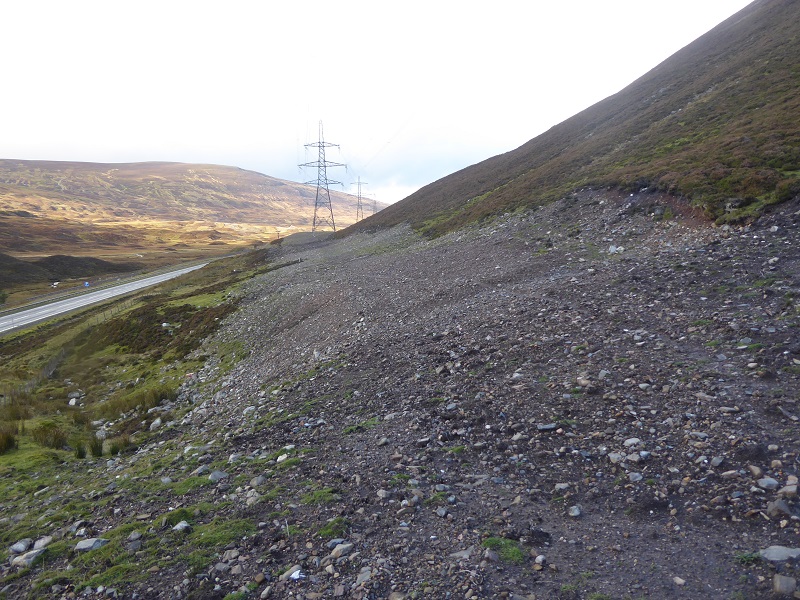
Its only as the former construction track approaches the Drumochter pass that the restoration work has attempted to remove the line of the cut and fill and mould the former track materials into the contours of the hillside. While a short section of bank (on right) has been left exposed, other restoration on this short stretch has been more successful with the horizontal bench across the hillside effectively removed, making it much harder for vehicles to drive here. Unfortunately the failure to store and replace vegetation means it will still form a very visible scar for some time. Vegetation reinstatement, rather than landscaping, is the main issue on this short section of the former construction track.

This photo shows what the hillside would look like if restored properly and provides a benchmark to judge the restoration.
The responsibility for restoring the damage to the landscape and what needs to happen
When planning consent was granted to the Beauly Denny the condition was that the section of ground covered in this post should be fully restored. The CNPA to its credit has been very concerned about the standard of restoration and I have been able to tell from correspondence obtained through FOI (eg Mr D Bryden CNPA Response 26 August 2015) that the CNPA were not properly consulted about the original mitigation measures and that after a Board Visit they raised issues at a senior level in SSE. This has had some effect and the CNPA is now involved in annual monitoring of the restoration. Unfortunately however the 2016 restoration monitoring report, which I obtained through FOI (see here), seems to show that Scottish and Southern Electric had managed to confine discussion of the issues to vegetation recovery and not wider landscape issues:
2 RESTORATION
2.1 THE DEFINITION OF FULL RESTORATION
The definition of “full restoration” is not necessarily straightforward, particularly for complex vegetation communities. Totally subjective or objective approaches are likely to be problematic and it is likely that it will be necessary to utilise a combination of both subjective and objective techniques for monitoring affected locations.
The broad definition of full restoration is more straightforward than the specific detailed approach to establishing that it has been achieved. In simple terms, following construction of the overhead line, it would be reasonable to expect that the habitat should be restored to one that is of similar type, structure, species composition and of at least equivalent quality/value to that which was present prior to construction. In achieving this, certain changes to the vegetation, that may occur as a result of the construction, restoration procedures, or through natural change (or anthropogenic change) and which may be either beneficial or adverse; need to be fully taken into account.
Now vegetation is important, and I don’t want to minimise in any way the importance of the inputs from CNPA staff on this or the SSE classification of vegetation recovery to date as adequate when it is clearly not. However, what appears to have been missing so far is full consideration of the landscape issues.
In my view both CNPA and SNH should now be calling on SSE to produce a proper landscape plan to restore the scar across the hillside caused by the failure to re-landscape the cut and fill track. Such restoration should make off road use of vehicles along the line of the former construction track very difficult, while specific action should be taken to prevent the estate from driving vehicles onto the flatter area of moorland between north Drumochter Lodge and Balsporran Cottages.
SSE have the money to pay for this. Moreover, where estates have gained permission for tracks to be retained, as north of Drumochter Lodge, this has saved SSE large sums which they would have had to spend on removing the tracks At the very least they should be using these savings to re-invest and ensure proper reinstatement of other sections of track. The landscape of the National Park deserves no less.
